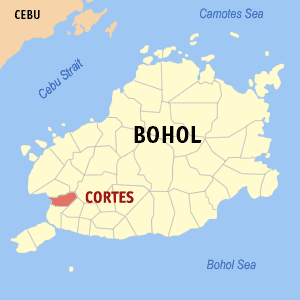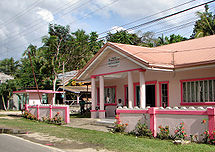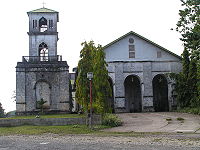
Cortes, Bohol
Encyclopedia


Philippines
The Philippines , officially known as the Republic of the Philippines , is a country in Southeast Asia in the western Pacific Ocean. To its north across the Luzon Strait lies Taiwan. West across the South China Sea sits Vietnam...
. It is about 10 kilometres (6.2 mi) northeast of the City of Tagbilaran. Its nearest neighbor along the national highway to the north is the town of Maribojoc
Maribojoc, Bohol
Maribojoc is a 4th class municipality in the province of Bohol, Philippines. According to the 2007 census, it has a population of 18,113 people....
. It was named after a town in Navarre, northern Spain
Cortes, Navarre
Cortes is a town and municipality located in the province and autonomous community of Navarre, northern Spain.-External links:*...
.
Located high up on a plateau, the town occupies a total land area of 4377 hectares (10,815.8 acre) with a population of 14,586 people according to the 2007 census. Belonging to the 1st Congressional District of Bohol, Cortes is politically subdivided into 14 barangay
Barangay
A barangay is the smallest administrative division in the Philippines and is the native Filipino term for a village, district or ward...
s:
- De la Paz
- Fatima
- Loreto
- Lourdes
- Malayo Norte
- Malayo Sur
- Montserrat
- New Lourdes
- Patrocinio
- Poblacion
- Rosario
- Salvador
- San Roque
- Upper de la Paz
History
The history of Cortes dates back to pre-hispanic times. They already had a form of government way before the coming of the Spaniards. The town was known as “Malabago” after its chief who was a co-temporary of King Lomod, otherwise known as TamblotTamblot
Tamblot was a babaylan or native priest from Bohol, Philippines who led the Tamblot Uprising in 1621 to 1622 during the Spanish era. He opposed the new religion spread by the Spaniards and fought against the subsequent conversion of the Boholanos to the Catholic faith. According to Legend, he...
– the first Boholano to raise arms against the Spanish conquistadors.
The Malabago settlement was situated in the upland territory of the present day Cortes near the Abatan River while that of Tamblot was at Barangay Viga in the lowlands of Antequera
Antequera, Bohol
Antequera is a 5th class municipality in the province of Bohol, Philippines. According to the 2007 census, it has a population of 14,357 people.A popular place of interest in Antequera are the Mag-Aso Falls...
which stretches to the riverside valleys opposite that of Malabago beyond the present day Abatan Bridge. The people of Malabago have a culture of their own and recorded their day-to-day activities in their own writing using unique characters which they carved out on a piece of bamboo using a knife called panggi or supok. Malabago then was a farming community that cultivated the land and made rice paddies in the north and east lowlands.
Tamblot’s reign started in early 1600 A.D. and the uprising in 1621 was triggered when a Spanish priest want to take back a silver church bell (Lingganayng Ugis) which he gave to Tamblot in order to put it up in a church he built at Malabago. Tamblot resented such a move; refused to give the bell back and so the feud between him and the Spaniards started. Supporting Tamblot during the uprising, the Spaniards destroyed the settlement in 1621.
The settlement was transferred to Bahian which was also destroyed by the Spaniards. Again the people settled at Ylaya at the upper part of the river. Not accessible by boats, the people had to berth near the mouth of the river which they eventually called as “Dayhangan”, meaning “berthing place”.
The people choose to live near the mouth of the river and along the swamps. Their main livelihood was to catch fish, so the new settlement was called “Pamingwitan” or a place where one can catch fish using a fishing rod. In 1793 or 94, an independent parish was established.
Finding it hard to pronounce the name of “Pamingwitan”, the town was re-named Cortes, after the Spanish conquistador, Hernan Cortes. Some said it was named after Cortes, a town in Navarre of Northern Spain. The town was probably established in 1862 during the construction of the Catholic Church wherein the settlements of Malabago, Pamingwitan and Dayhangan where welded into one and called the “Pueblo de Cortes” derived from the Spanish word “cortesimo” meaning “most courteous”.
The parish was dedicated to the Santo Niño. The inhabitants of the town were baptized and given instructions in the Catholic faith. Although the church was built in 1880, the bell towers’ upper register was completed only in the 20th century. A boy’s school building was constructed in 1895.
The town of Cortes played a prominent role during World War II. The inhabitants of the town formed a bolo battalion to fight the Japanese Invaders. Yet in 1942, the town was overwhelmed by the Japanese; houses were burned down and the school building was occupied and used as a garrison. Cortes was liberated from the Japanese a few days after the arrival of the Americans in Tagbilaran on April 11, 1945. In less than a month, the whole province of Bohol was officially declared liberated on May 25, 1945, by Major General William H. Arnold, Commander of the American Division.
Economy

The town is also known for handmade paper products chosen now as the town’s priority product under the Department of Trade and Industry’s One Town, One Product (OTOP) Program. Aside from the manufacturing and handicraft industries, the people of Cortes are also into agribusiness.
Sand taken from the Abatan River, and which usually finds its way to construction sites in Tagbilaran City, is likewise another source of income for the people of Cortes. Flat-bottomed boats made of marine plywood carry the sand which has to be dug up from the river bed with waist high waters - a back-breaking work for those involved.
The Local Government Unit (LGU) of Cortes with Mayor Jasmin Balistoy in the lead is also developing eco-tourism. One major project is the development of the docking port, envisioned to be the starting point for cruises on the Abatan River.
The Abatan River flows thru five towns thus these towns will be benefited if the Abatan River Cruise will be in full swing. Livelihood projects can then be established promoting each of the town’s special products under the OTOP program.
The LGU are also eyeing some sites for future development such as the Bilibili Spring, Larga Vista, Municipal Hall and more in an effort to make the town of Cortes attractive to tourists.
Other projects include the establishment of day care centers in each of the town’s 14 barangays. Health stations will also be constructed. The nine sources of water supply are now installed with automatic chlorinator injection system to insure the health of residents. A big water reservoir will also be constructed in barangay De la Paz.
People there are literate and English speaking - what with English as the medium of instruction in all schools in the town starting from the primary grades. The people also speak Visayan and Filipino.
Deeply religious, the people of Cortes in majority are Roman Catholics. They celebrate the town fiesta every 16th of January in honor of the holy child Jesus, the Sto. Niño - and this with much flowing drinks, delicious food, fanfare and rejoicing!
Attractions
The town of Cortes has several sites worthy of a visit yet needs further development in order to attract foreign tourists. The Local Government Unit of the town is now geared towards the improvement and promotion of these attractions in line with the province-wide tourism pursuits.Abatan River
The Abatan River is one of its natural assets. The winding river snakes thru the town of Antequera and up to the town of Balilihan for an estimated length of 20 kilometres (12.4 mi). It opens at the Cortes nipa swamp, the most extensive nipa swamp in Bohol.In former days when roads were scarce, the river served as a waterway for the people to and from the interior towns. Now, the government has seen its potential for tourism after the success of the Loboc River
Loboc River
The Loboc River is a river on Bohol Island, the Philippines. It is one of the major tourist destinations of Bohol, local and foreigners alike. The winding river plays host to cruises on board of small bancas or floating restaurants...
tours and it is now being developed.
Kayak exploration is now available and can be arranged.
The Abatan River Community Life tour is now operational and information can be accessed at their web site : http://www.riverlife.ph
Cortes Church

The church is made up of cut coral stone blocks. A portico is in front of an older façade and floral carving frames the doorway. It has frescoes on its ceilings. The main retablo has twisted Solomonic columns and profusely carved flanges in the Baroque idiom. The Cortes Church is a must-see especially for the religious pilgrims.
Bilibili Spring
The Bilibili Spring is another site envisioned for development by the local government for it will be the first stop of the proposed river cruise. It is a much-loved nook of the local inhabitants; a place to while away the time while communing with nature and being refreshed by the cool spring waters. The spring is located in barangay Malayo Norte.Cortes town is rife with natural attractions which need to be enhanced further to make it worthy for promotion. The Bacong River Heritage Conservation Tour for paddling and river trekking enthusiasts has been set up. Other sites such as the Larga Vista, an old stone building and the municipal hall are must-see.

